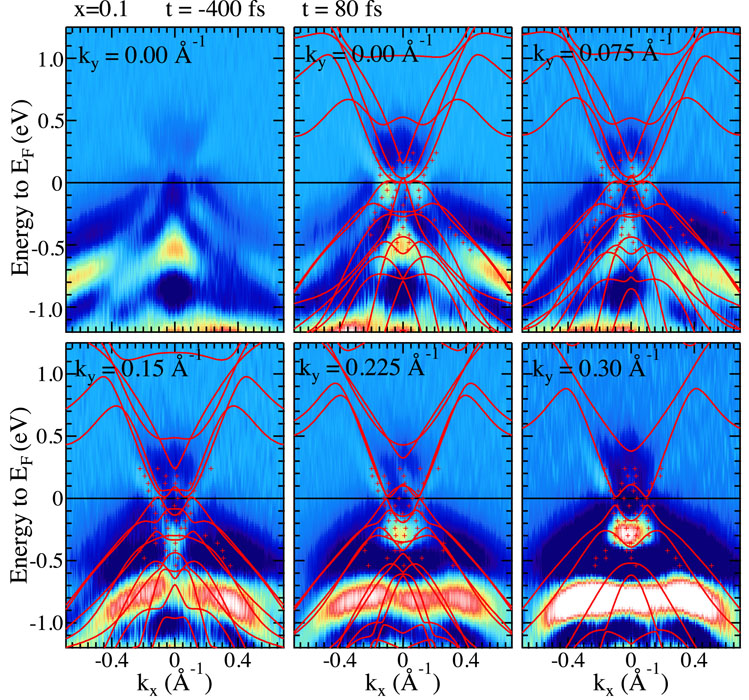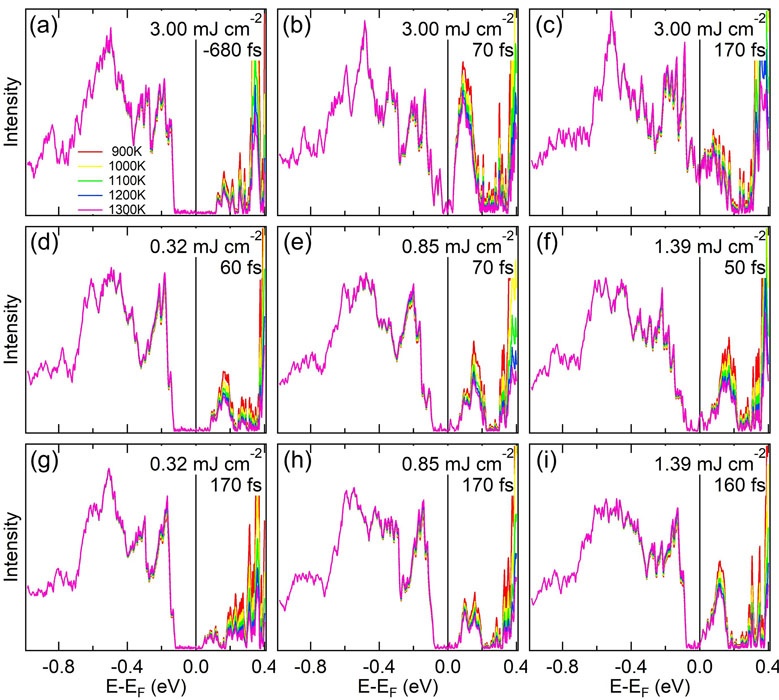Time-Resolved Angle-Resolved Photoemission Spectroscopy on Ta2Ni0.9Co0.1Se5
PI of Joint-use project: T. Mizokawa
Host lab: Okazaki Group
Host lab: Okazaki Group
Ultrafast optical response of Ta2Ni0.9Co0.1Se5 has been studied by means of time-resolved angle-resolved photoemission spectroscopy (tr-ARPES). The Ti:Sapphire laser pulse with hν = 1.55 eV was used for the pump light and its higher harmonics with hν = 21.7 eV was employed for the probe light. The temporal resolution of the tr-ARPES is about 80 fs. Ta2Ni0.9Co0.1Se5 has a quasi one-dimensional crystal structure (Ta chain and Ni chain run along the a axis) and is one of the excitonic insulator (EI) candidates where the transition temperature is reduced by Co substitution in Ta2NiSe5. Under the sufficient incident fluence (1.9 mJ cm-2), the conduction band is clearly observed above the Fermi level and the energy gap between the conduction and valence bands is closed at the delay time about 150 fs [1]. This observation suggests a photoinduced phase transition from the EI state to a semimetal state. The observed band dispersions of the semimetal phase roughly agree with the generalized gradient approximation (GGA) calculation which fails to reproduce the band gap at the ambient condition.
In Fig. 1, the tr-ARPES spectra of the semimetal phase are differentiated two times with respective to energy and are smoothed [2]. In this measurement, the Fermi surfaces are observed even before the arrival of the pump pulse (-400 fs). kx represents a momentum along the Ta/Ni chain direction along which the valence and the conduction bands exhibit large dispersions. The kx dispersions appreciably depend on ky which is a momentum perpendicular to the Ta/Ni chains. The crosses indicate the band positions extracted from the momentum distribution curves (MDCs). The agreement between the band positions and the band structure calculations is not perfect, but the positions of the valence and conduction bands are roughly reproduced. Most probably, the electron-hole interaction, which is not exactly included in GGA, is screened out by the photoexcited carriers. In the photoinduced semimetal phase, the conduction and valence bands provide quasi one-dimensional Fermi surfaces with similar momentum positions suggesting a quasi one-dimensional line-node semimetal.

Fig. 1. The second derivatives of the tr-ARPES spectra with respective to energy as functions of kx for Ta2Ni0.9Co0.1Se5, which are taken at 100 K with pump-probe delay of -400 fs (only ky = 0.00 Å−1) and about 100 fs (ky = 0.00, 0.075, 0.15, 0.225, and 0.30 Å−1). The symbols indicate the band positions extracted from MDCs. The solid curves indicate calculated GGA band dispersions for Ta2NiSe5.
In most of the tr-ARPES measurements, the EI gap of Ta2Ni0.9Co0.1Se5 remains before the pump pulse arrival and is gradually suppressed after the pump pulse excitation. Such spectral behavior is clearly demonstrated in Fig. 2, where the energy distribution curves (EDCs) are numerically deconvoluted and divided by Fermi-Dirac distribution functions in order to extract the intrinsic spectral function [3]. With the fluence of 3.00 mJcm-2 and at the delay time of 70 fs, the valence band top does not reach the Fermi level creating a partial gap or a pseudogap, and the transition from the EI state to the semimetal state is not completed. While the conduction band crossing the Fermi level is observed with the shorter delay time (down to 50-70 fs) and/or the lower fluence (down to 0.32 mJ cm−2), the valence band top stays well below the Fermi level up to the fluence of 1.39 mJ cm−2 even at the delay time of 150-170 fs. Only with the highest fluence (3.00 mJ cm-2) and the delay time of 150-170 fs, the gap (or pseudogap) at the Fermi level is closed. Such different optical responses of the valence and conduction bands cannot be explained by the canonical EI scenario, suggesting a vital role of electron-lattice coupling. One can speculate that the fluctuations of the Ni-Se bond, which can be coupled to the negative charge-transfer energy state (d9L state) of Ni (L represents a Se 4p hole), remain at the 50-70 fs delay time and suppress the valence band shift. Around the delay time of 150-170 fs, the lattice fluctuations are screened out due to the photoexcited holes resulting in the semimetal phase with the substantial energy overlap between the conduction and valence bands. Such electron-lattice coupling is expected to be weak for the Ta-Se bond where the extended Ta 5d orbitals form the conduction band.

Fig. 2. EDCs (integrated in the kx range between 0.05 and -0.05 Å−1) deconvoluted and divided by the Fermi-Dirac distribution functions at the delay time of (a) -680 fs, (b) 70 fs, and (c) 170 fs for the fluence of 3.00 mJ cm−2. Deconvoluted EDCs at 50-70 fs for the fluence of (d) 0.32 mJ cm−2, (e) 0.85 mJ cm−2, and (f) 1.39 mJ cm−2. Deconvoluted EDCs at 150-170 fs for the fluence of (g) 0.32 mJ cm−2, (h) 0.85 mJ cm−2, and (i) 1.39 mJ cm−2.
References
- [1] T. Mitsuoka, T. Suzuki, H. Takagi, N. Katayama, H. Sawa, M. Nohara, M. Watanabe, J. Xu, Q. Ren, M. Fujisawa, T. Kanai, J. Itatani, S. Shin, K. Okazaki, and T. Mizokawa, J. Phys. Soc. Jpn. 89, 124703 (2020).
- [2] T. Mitsuoka, Y. Takahashi, T. Suzuki, M. Okawa, H. Takagi, N. Katayama, H. Sawa, M. Nohara, M. Watanabe, J. Xu, Q. Ren, M. Fujisawa, T. Kanai, J. Itatani, K. Okazaki, S. Shin, and T. Mizokawa, J. Phys. Soc. Jpn. 92, 023703 (2023).
- [3] Y. Takahashi, T. Suzuki, M. Hattori, M. Okawa, H. Takagi, N. Katayama, H. Sawa, M. Nohara, Y. Zhong, K. Liu, T. Kanai, J. Itatani, S. Shin, K. Okazaki, and T. Mizokawa, J. Phys. Soc. Jpn. in press.
